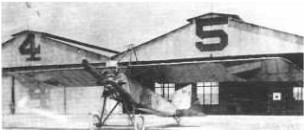Updated: 27-Sep-2024
TALLERES NACIONALES DE CONSTRUCCIONES AERONAUTICAS
(Mexico)
TALLERES NACIONALES DE CONSTRUCCIONES AERONAUTICAS engine specifications
This company was also known as TNCA and was founded in 1915.
-The truth is that since the first years of motorized aviation they already built aeronautical material such as airplanes, engines and propellers.
-In their revolutionary civil war they already used French and American airplanes.
-They acquired licenses to build them and soon Mexican airplanes appeared such as the Series A and H.
-The first engine licenses were from Anzani, Gnome e Hispano-Suiza, (and the 180 HP BMW).
-The airplanes built at TNCA intervened in the Mexican civil war.

“TNCA Series H airplane with an Aztatl engine”
-The Serie C airplanes were powered by the 150 HP Hispano Suiza like the engine that is still exhibited at the FAM Museum.

“Hispano-Suiza engine at the FAM Museum”
-The first three engines built were:
-The “Trébol” licensed by the Anzani with 3 cylinders and 45 HP.
-The “Aztatl” from 1917 was the Anzani with 6 cylinders and 80 HP. By the way, the name Aztatl comes from “Garza Blanca” in Nahuatl.
-Here we have a doubt because it is stated in a publication that the Garza Blanca was an original Mexican design from 1916 and with the pistons on the outside (?).
-Insistent clarification “Garza Blanca” is “Aztatl” in Nahuatl.
-In 1916 the Barcelona brand Hispano-Suiza (see) created the SS México in Mexico to introduce its engines.
-Another Mexican design was the 10-cylinder, 110 HP engine, but its origin or lineage is not confirmed. The search is still ongoing, although other references only give it as a national design.
From Appendix 12: The company is Talleres Nacionales de Construcciones Aeronáuticas. The Trébol was the three-cylinder engine of which we have obtained two new illustrations.

“The three-cylinder Trébol”
-It cannot be said that it is a copy or derivative of the Anzani, since at that time -1920- there were already several brands that used this architecture. The truth is that the central block is very original, triangular.

“Military plane with Trébol engine, in 1920”
-The engine and the aircraft were TNCA products
Motores de TALLERES NACIONALES DE CONSTRUCCIONES AERONAUTICAS
Model: Antoinette and Renault
Model: Azatl, 10 cyl.
Arquitecture:
Cooling:
Total Displacement:
Bore / Stroke: x
Power:
Weight:
Model: Azatl, 3 cyl.
Arquitecture:
Cooling:
Total Displacement:
Bore / Stroke: x
Power:
Weight:
Model: Aztatl (Anzani 6 cyl. 80 cv, lic)
Arquitecture:
Cooling:
Total Displacement:
Bore / Stroke: x
Power:
Weight:
Model: Gnome (lic.)
Arquitecture:
Cooling:
Total Displacement:
Bore / Stroke: x
Power:
Weight:
Model: Hispano Suiza (lic.)
Arquitecture:
Cooling:
Total Displacement:
Bore / Stroke: x
Power:
Weight:
Model: Renault (lic.)
Arquitecture:
Cooling:
Total Displacement:
Bore / Stroke: x
Power:
Weight:
Model: SS México, 10 cyl. 150 hp
Arquitecture:
Cooling:
Total Displacement:
Bore / Stroke: x
Power:
Weight:
Model: Trébol (Anzani, 3 cyl. 45 cv, lic.)
Arquitecture:
Cooling:
Total Displacement:
Bore / Stroke:
Power:
Weight:
Model: Wright (lic.)
Arquitecture:
Cooling:
Total Displacement:
Bore / Stroke: x
Power:
Weight:


